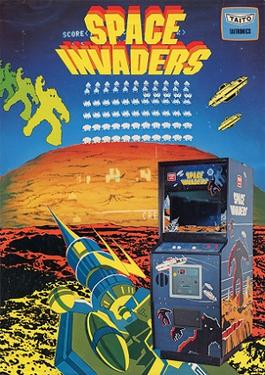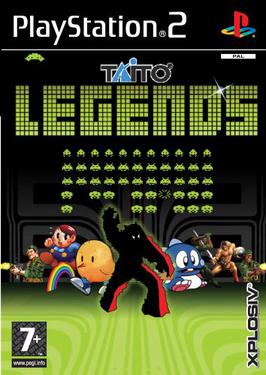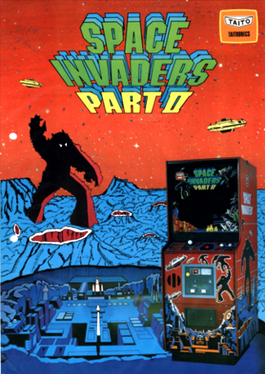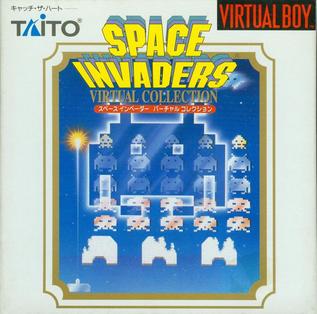
Taito Corporation is a Japanese company that specializes in video games, toys, arcade cabinets, and game centers, based in Shinjuku, Tokyo. The company was founded by Michael Kogan in 1953 as the Taito Trading Company, importing vodka, vending machines, and jukeboxes into Japan. It began production of video games in 1973. In 2005, Taito was purchased by Square Enix, becoming a wholly owned subsidiary by 2006.

Space Invaders is a 1978 shoot 'em up arcade video game developed and published by Taito. It was released in Japan in April 1978, with the game being released by Midway Manufacturing overseas. Commonly considered to be one of the most influential video games of all time, Space Invaders was the first fixed shooter and the first video game with endless gameplay and set the template for the genre. The goal is to defeat wave after wave of descending aliens with a horizontally moving laser cannon to earn as many points as possible.

Arkanoid is a 1986 block breaker arcade game developed and published by Taito. In North America, it was published by Romstar. Controlling a paddle-like craft known as the Vaus, the player is tasked with clearing a formation of colorful blocks by deflecting a ball towards it without letting the ball leave the bottom edge of the playfield. Some blocks contain power-ups that have various effects, such as increasing the length of the Vaus, creating several additional balls, or equipping the Vaus with cannons. Other blocks may be indestructible or require multiple hits to break.

Breakout is an arcade video game developed and published by Atari, Inc. and released on May 13, 1976. It was designed by Steve Wozniak, based on conceptualization from Nolan Bushnell and Steve Bristow, who were influenced by the seminal 1972 Atari arcade game Pong. In Breakout, a layer of bricks lines the top third of the screen and the goal is to destroy them all by repeatedly bouncing a ball off a paddle into them. The arcade game was released in Japan by Namco. Breakout was a worldwide commercial success, among the top five highest-grossing arcade video games of 1976 in both the United States and Japan and then among the top three highest-grossing arcade video games of 1977 in the US and Japan. The 1978 Atari VCS port uses color graphics instead of a monochrome screen with colored overlay.

Jungle Hunt, is a side-scrolling action game developed by Taito for arcades. It was originally distributed in 1982 as Jungle King, then quickly modified and re-released as Jungle Hunt following a copyright dispute over the player character's likeness to Tarzan. Taito also distributed a less successful rebranding of the game as Pirate Pete in 1982. Jungle King, along with Moon Patrol released a month earlier, is one of the first video games which has parallax scrolling.

Phoenix is a fixed shooter video game developed for arcades in Japan and released in 1980 by Taito. The player controls a space ship shooting at incoming enemies that fly from the top of the screen down towards the player's ship. There are five stages which repeat endlessly. The fifth is a fight against a large enemy spaceship, making Phoenix one of the first shooters with a boss battle, an element that would become common for the genre.

Tomohiro Nishikado is a Japanese video game developer and engineer. He is the creator of the arcade shoot 'em up game Space Invaders, released to the public in 1978 by the Taito Corporation of Japan, often credited as the first shoot 'em up and for beginning the golden age of arcade video games. Prior to Space Invaders, he also designed other earlier Taito arcade games, including the shooting electro-mechanical games Sky Fighter (1971) and Sky Fighter II, the sports video game TV Basketball in 1974, the vertical scrolling racing video game Speed Race in 1974, the multi-directional shooter Western Gun in 1975, and the first-person combat flight simulator Interceptor (1975).
The following article is a broad timeline of arcade video games.
1979 saw many sequels and prequels in video games, such as Space Invaders Part II and Super Speed Race, along with new titles such as Asteroids, Football, Galaxian, Head On, Heiankyo Alien, Monaco GP, Sheriff and Warrior. For the second year in a row, the highest-grossing video game was Taito's arcade game Space Invaders and the best-selling home system was the Atari Video Computer System.
1978 saw the release of new video games such as Space Invaders. The year is considered the beginning of the golden age of arcade video games. The year's highest-grossing video game was Taito's arcade game Space Invaders, while the best-selling home system was the Atari Video Computer System.

Taito Legends is a compilation of 29 arcade games released for the PlayStation 2, Xbox, and Microsoft Windows. The games were originally developed by Taito. The European release was published by Empire Interactive, who had licensed the games from Taito and developed the compilation. Although they did not get official credit for it in the American versions, Sega published the North American and South American releases.

Space Invaders Part II is a 1979 fixed shooter arcade video game developed and published by Taito. In North America, it was distributed by Midway Games as Space Invaders Deluxe. It is the sequel to Space Invaders (1978). The player controls a laser base that must destroy formations of descending aliens, while avoiding their projectiles. New features have been added, such as aliens that split into two when shot, an increased high score limit with the player able to save their name as initials, and short cutscenes in-between stages. It runs on the Taito 8080 arcade system.

is a 1995 compilation video game developed and published by Taito in Japan for the Virtual Boy. It includes direct ports of the arcade game Space Invaders (1978) and its direct sequel Space Invaders Part II (1979), alongside 3D remakes that take advantage of the Virtual Boy's hardware capabilities. Both games feature a number of alternative gameplay modes, such as score attack and time attack modes.
is an arcade game released by Taito in November 1979. The gameplay has some resemblance to both Taito's own 1978 hit Space Invaders and Atari, Inc.'s Lunar Lander.
Space Invaders is an arcade video game designed by Tomohiro Nishikado in 1978.

Space Gun is a 1990 first-person shooter arcade game released by Taito. The game is set aboard a crippled space station that has been overrun by hostile alien creatures. The objective is to rescue human crew members while destroying the alien creatures. The game lets the player shoot limbs off the creatures, resulting in blood splatters.

Football is a 1978 American football video game developed and released by Atari, Inc. for arcades. Players are represented by X's and O's. While predated by Sega's World Cup, Football is credited with popularizing the trackball controller and is also the first non-racing vertically scrolling video game. It was distributed in Japan by Namco in 1979.

Speed Race is a 1974 arcade racing video game developed and manufactured by Taito and released under the titles Racer and Wheels in North America by distributor Midway Manufacturing in 1975. Designed by Tomohiro Nishikado, the gameplay involves the player using the attached steering wheel to maneuver a car alongside a fast vertical scrolling road. The objective is to score points by driving past other cars without colliding with them; more points are awarded for driving faster. Players must do this under a 90-second time limit, which ends the game when it runs out. The gameplay concepts were adapted from two earlier driving electro-mechanical games: Kasco's Mini Drive (1958) and Taito's Super Road 7 (1970).

Space Invaders is a 1980 video game based on Taito's arcade game Space Invaders (1978) for the Atari 2600. It was developed and released by Atari, Inc. and designed and developed by Rick Maurer. The game is based on the arcade game in which a player operates a laser cannon to shoot at incoming enemies from outer space. Maurer's version has unique graphics and offers some gameplay variations. These include a two-player mode and variations that allow for invisible enemies and moving shields, and for enemies shots to zig zag and potentially hit players.














